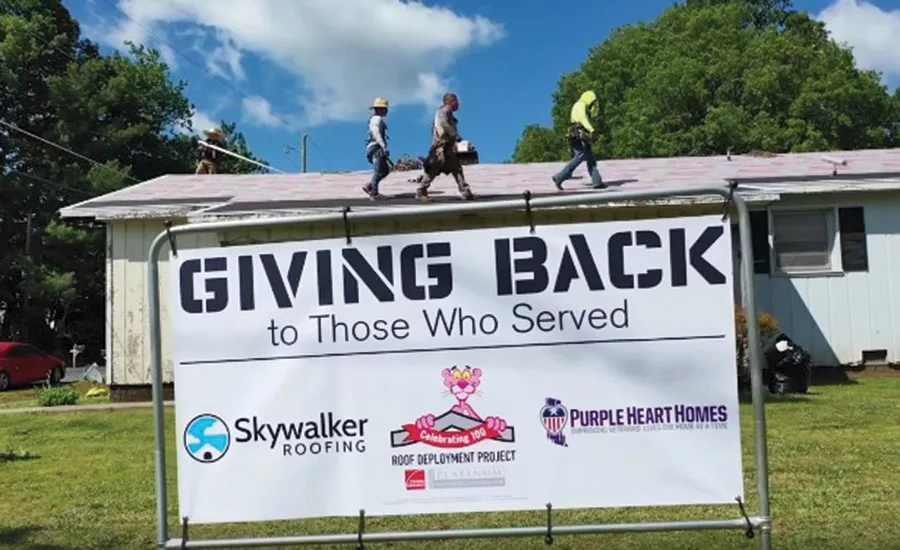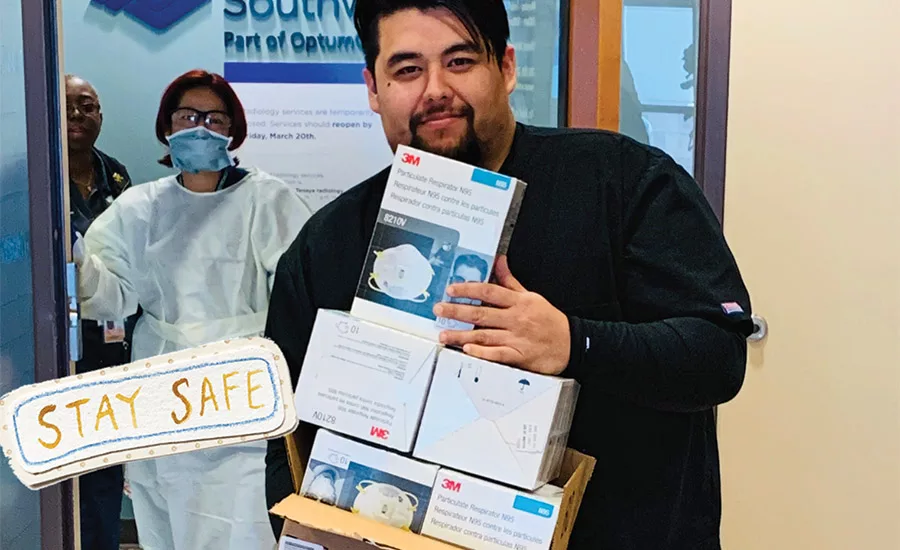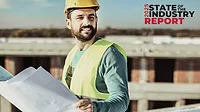COVID-19: Roofing Contractors Across the U.S. Strike the Balance of Staying Safe While Economically Viable
COVID-19 Crisis: Ready to Reopen


Photo: Skywalker Roofing/Facebook.


Commercial Roofers Inc. donated 100 N95 masks to local medical facilities/staff, and challenged other construction companies to do the same. Photo courtesy of Commercial Roofers Inc.
Over the past three to four weeks, roofing contractors across the country that were unable to remain open during the onset of the COVID-19 pandemic have been getting back to work — cautiously.
As they should, according to industry leaders balancing the fragile line between keeping workers safe and keeping them employed.
“It needs to be a gradual return,” said Trent Cotney, of Cotney Construction Law, about his guidance to roofing contractors on return-to-work procedures. “It’s best not to take a strong-arm approach to this. Make sure you’re following the proper guidelines so that it gives employees the assurance they can come back to work.”
While some states — like New York and California — enforced major shutdowns to construction operations due to high concentrations of COVID-19 outbreaks, roofing contractors in other states like Georgia and Colorado remained largely on-the-job. Regardless of the stage of reopening, roofers across several states said the keys to moving forward were open communication, maximizing office and jobsite space and maintaining new health protocols while staying positive.
Safe Return
Getting back to work was a mixed scenario for Kodiak Roofing & Waterproofing in Northern California. The commercial and industrial roofing contractor had non-union crews working on a sizeable backlog throughout the crisis, while its union division was idled by government shutdowns in the San Francisco Bay Area. As those restrictions lifted in a six-county area by mid-May, Kodiak was able to put roughly 70 crewmembers back into action.
More on COVID-19
Innovating while Indoors: Creative Ways to Help with PPE
Roofers Give Back Despite Slow Business
Training and Education Opportunities During the COVID-19 Crisis
“All the guys sitting at home are excited about getting back to work and participating in taking care of the bills,” President Duane Nash said at the time.
In Denver, Empire Roofing crews continued roofing throughout the pandemic, but had to adhere to social distancing recommendations and other safety measures. Commercial crews were split up into different trucks, kept their distance on the rooftop, and wore masks and gloves on the jobsite, said Cal Schreiner, national accounts manager.
The potentially-lethal virus’ rapid spread created seemingly-constant changes to health and safety standards. That made regular engagement and positive messaging both internally and to customers a key focal point early on in the crisis.
“As soon as the stay-at-home orders were declared, we contacted each of our customers and provided them with a letter from CEO Richard Nugent explaining the actions we’re taking to protect them and our teammates from COVID-19,” said John Geary, chief marketing officer with Nations Roof. “We included our Pandemic Preparedness Plan that outlined the preventive steps we were taking as well as how we would respond to a situation where one of our employees tested positive for coronavirus. The feedback we received was very positive from our customers.”
Attitudes toward safety also seemed to differ in separate parts of the country. Wearing protective gear was not the norm in Oregon, where restrictions were relatively laid back.
“People here are kind of lax about it,” said Pacific West Roofing Owner Stan Robinson. “I had a lady (in her 70s) come up to me and touch me on the elbow, and I was like, ‘We’re trying to keep you and our guys safe.’”
During the first month of the pandemic, Robinson said sales skyrocketed for their residential roofing business as homebound homeowners discovered leaks while cleaning out their closets and attics. Many customers also bumped home improvement projects up their “to-do” lists after vacation plans dissolved due to the crisis.
“We geared for that and doubled-up on our repair crews and crashed through a lot of work,” he said.
That demand did subside, however, which made maintaining regular operations a challenge without assistance through the Paycheck Protection Program that pumped trillions of federal money into the economy.
Data from Clear Seas Research — the survey and research arm of RC’s parent company, BNP Media — showed just 23% of contractors applied for and received the stimulus funds. Robinson said he felt lucky to apply and be approved early in the process while others couldn’t get through. At the same time he also recognized the risks.
“There’s a lot of unknowns about what is considered forgivable and what is not … and we’re waiting to hear on that,” he explained. “But I have no problem giving it back if we don’t need it, because I think the ones that will really need it are those businesses that have been completely stopped.”
Surveying the Situation
With so much uncertainty about how the economy will rebound, many roofing contractors said getting back up to the level of operational efficiency they had before the pandemic will be a challenge.
As mentioned earlier, Clear Seas Research conducted a series of weekly surveys of professionals across several industries from late March to early May. As of the most recent data available, about 38% of contractors that responded indicated they could rebound to regular business levels within three months or less. Another 27% said it could happen within four to six months.
For some, ramping up quickly depended on how well roofing contractors were already using technology in the field.
“Prior to COVID-19, we implemented several mobile technologies that have been instrumental in allowing us to continue to work and provide excellent customer service,” said Leo Ruberto, owner and president of Ohio-based Feazel Inc. “They have also allowed us to follow social distancing policies while still feeling connected with our customers.”
The same survey showed that roughly 70% of contractors saw a decline in new business activity as the crisis deepened. That put more of an emphasis on backlogs and keeping working crews healthy. In places where companies could work, roofing — and the construction industry overall — showed strong resiliency. About half of contractors indicated their active business projects remained on schedule through early May, and the amount of canceled active business never reached higher than 19% throughout the survey period. The results were similar for projects already in the planning stages.
Once the backlog thinned, some focused on new marketing tactics, despite conventional wisdom to do otherwise. From early April to early May, 56% to 60% of contractors indicated a decline in their marketing budgets. Just 12% of respondents consistently said they’d increase marketing funds during the pandemic. For some, it made sense if their competition wasn’t putting themselves out there and may be struggling to garner new leads, too.
“This is the time to market, to actually invest and get people in so that when the onslaught of work does come you’re geared up,” Robinson said.
With tough times also comes opportunity, even regarding available workforce — the roofing industry’s chief problem before the pandemic hit.
“We’ve actually had more success lately getting new applicants coming in,” Schreiner said. “Some have roofing backgrounds, but a lot of them are looking for a place to work from other trades. We’re getting a lot more than a few months ago.”
With more bid work on the way for peak season, Schreiner said Empire is scaling up recruitment for the future.
The optimism appears to be shared across the industry.
While the number of contractors expressing their overall concern about the economy hovered between 69% to 73% during the successive surveys, those concerned about achieving business goals over the next three months fell from 68% in March to 60% by May 1. Concerns over supply-chain interruptions also fell as the pandemic continued (36% to 31%), as did concerns over becoming personally infected with COVID-19 (47% to 38%).
Despite the damage COVID-19 has already done, roofing contractors are coming to the realization that while the economy may be reopened, safety issues stemming from the virus are far from over.
“Safety concerns will still linger throughout the summer,” Ruberto said. “We’ll remain diligent. We are gearing up for summer and peak season as we normally would but also planning to continue to infuse safety protocols into our operations, even once various stay-at-home restrictions are lifted. I’m grateful that we have implemented several mobile-focused technologies. I believe these technologies will continue to help us move the business forward with peak season around the corner, in the midst of all the health uncertainties we are still facing.”
Looking for a reprint of this article?
From high-res PDFs to custom plaques, order your copy today!








